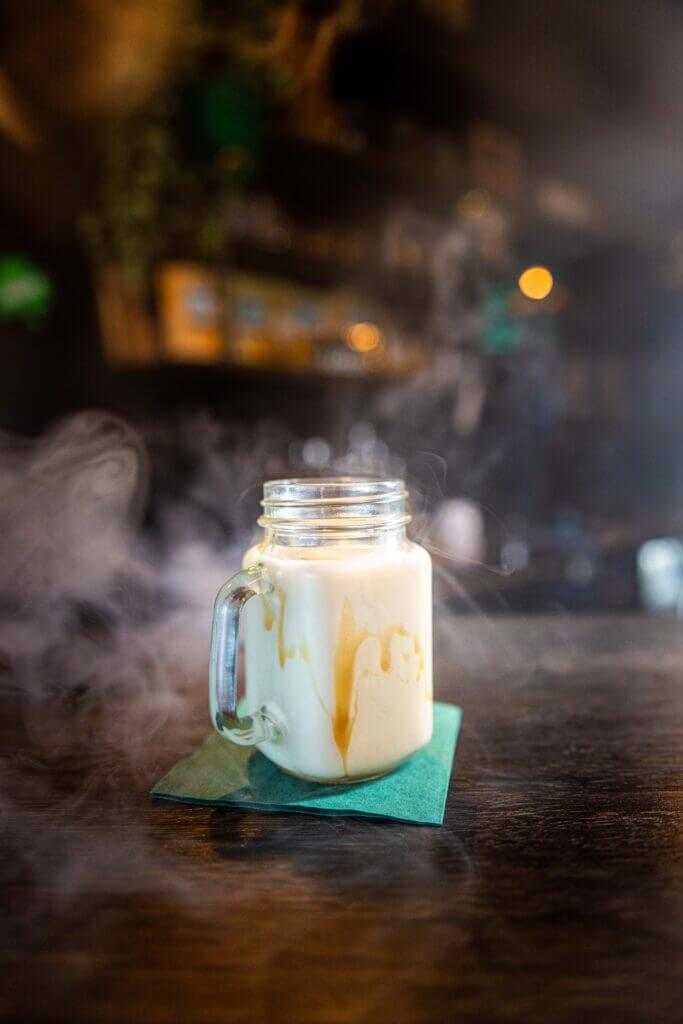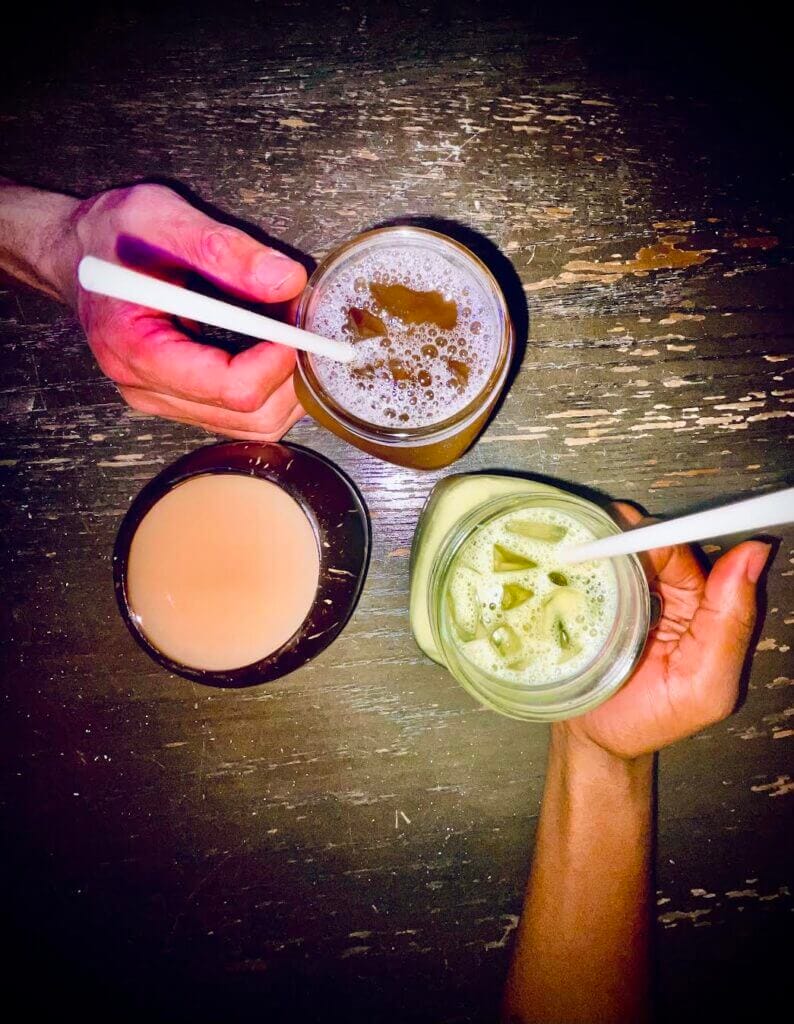What’s the difference between kava and kratom? We have answers & recipes.
Kratom Tea and Kava Tea are two distinct herbal beverages with different origins, effects, and cultural backgrounds. Let’s delve into each of them in detail:

Kratom Tea:
Kratom Tea Origins:
Kratom (Mitragyna speciosa) is a tropical evergreen tree native to Southeast Asia, particularly in countries like Thailand, Indonesia, Malaysia, and Myanmar. The leaves of the Kratom tree have been traditionally used in these regions for various medicinal and recreational purposes.
Kratom Tea Preparation:
Kratom tea is made by steeping the dried or powdered leaves of the Kratom tree in hot water. The leaves contain alkaloids, particularly mitragynine and 7-hydroxymitragynine, which are believed to have psychoactive properties.
Effects of Kratom Tea:
Kratom is known for its dual properties, acting as both a stimulant and a sedative, depending on the dosage. In lower doses, it can produce stimulating effects, including increased energy, alertness, and sociability. In higher doses, it tends to have more sedative and analgesic (pain-relieving) effects.
Usage of Kratom Tea:
Kratom has been used traditionally in Southeast Asia for various purposes, including pain relief, mood enhancement, and as a recreational substance. However, it has also been a subject of controversy due to potential health risks and regulatory concerns in some countries.

Concerns:
There are safety concerns associated with kratom use, including the risk of dependence and withdrawal symptoms. The legality of kratom varies globally, with some countries and regions banning its use due to safety concerns.
Kava Tea:
Origin of Kava Tea:
Kava (Piper methysticum) is a plant native to the South Pacific islands, including Fiji, Vanuatu, Tonga, and Hawaii. The roots of the kava plant are used to prepare a traditional ceremonial beverage with a long history in Pacific Island cultures.
Preparation of Kava Tea:
Kava tea is made by grinding the root of the kava plant and then soaking it in cold or lukewarm water. The active compounds in kava include kavalactones, which have psychoactive properties.
Effects of Kava:
Kava is known for its calming and relaxing effects. It is often consumed in social or ceremonial settings and is said to promote a sense of well-being without impairing mental clarity. Kavalactones in kava have anxiolytic (anxiety-reducing) and muscle relaxant properties.
Kava Tea Usage:
Kava has a long history of traditional use in the South Pacific, where it is often consumed in social and ceremonial gatherings. It has gained popularity in other parts of the world as a relaxation aid.
Concerns about kava:
While kava has a long history of use in its native regions, there have been concerns about the potential for liver toxicity associated with certain kava products. Some countries have restricted or banned the sale of kava due to these concerns, although in others, it is still legally available.

Differences between kava and kratom:
- Origin:
- Kratom is native to Southeast Asia.
- Kava is native to the South Pacific islands.
- Preparation:
- Kratom tea is made by steeping the leaves of the Kratom tree.
- Kava tea is made by soaking the ground root of the kava plant.
- Effects:
- Kratom has stimulant and sedative properties, depending on the dosage.
- Kava is known for its calming and relaxing effects.
- Usage:
- Kratom has been traditionally used for various purposes, including pain relief and recreation.
- Kava has a strong cultural and ceremonial significance in the South Pacific and is often consumed in social settings.
- Concerns:
- Kratom has faced regulatory scrutiny and concerns about potential dependence.
- Kava has been associated with liver toxicity concerns in some cases.
It’s crucial to note that both kratom and kava have varying legal statuses in different countries, and individuals should be aware of and adhere to the regulations in their respective locations. Additionally, anyone considering the use of these substances should consult with a healthcare professional, as there may be potential risks and interactions with other medications.

Kava Tea Recipes:
- Traditional Kava Tea:
- Ingredients:
- Kava root powder (2-4 tablespoons)
- Cold water (2 cups)
- Instructions:
- Place the kava root powder in a large bowl or muslin bag.
- Add cold water and knead or squeeze the kava root powder for about 10-15 minutes.
- Strain the liquid into a separate bowl or container.
- Serve the strained kava tea in small cups and enjoy.
- Ingredients:
- Kava Chai Tea:
- Ingredients:
- Kava root powder (2 tablespoons)
- Chai tea bag (1)
- Honey or sweetener of choice
- Instructions:
- Brew a chai tea bag in hot water.
- Add kava root powder to the brewed chai tea.
- Stir well and let it steep for 5-10 minutes.
- Sweeten with honey or your preferred sweetener.
- Ingredients:
- Coconut Kava Cooler:
- Ingredients:
- Kava root powder (2-3 tablespoons)
- Coconut water (2 cups)
- Ice cubes
- Instructions:
- Mix kava root powder with coconut water.
- Stir well until the kava is dissolved.
- Add ice cubes and enjoy a refreshing coconut-flavored kava drink.
- Ingredients:
- Kava Mint Lemonade:
- Ingredients:
- Kava root powder (2 tablespoons)
- Freshly squeezed lemon juice (1/4 cup)
- Mint leaves (a handful)
- Agave syrup or sweetener
- Instructions:
- Mix kava root powder with lemon juice.
- Add fresh mint leaves and sweeten to taste.
- Allow it to steep for a few minutes and strain if desired.
- Ingredients:
- Kava Spice Infusion:
- Ingredients:
- Kava root powder (2 tablespoons)
- Cinnamon stick (1)
- Ginger (freshly grated, 1 teaspoon)
- Cloves (2-3)
- Instructions:
- Combine kava root powder with the spices in a pot.
- Add hot water and simmer for 15-20 minutes.
- Strain and serve this warm, spiced kava tea.
- Ingredients:

Kratom Tea Recipes:
- Basic Kratom Tea:
- Ingredients:
- Kratom powder (2-4 grams)
- Water (2 cups)
- Instructions:
- Boil water and add kratom powder.
- Simmer for 15-20 minutes.
- Strain the liquid and enjoy.
- Ingredients:
- Citrus Kratom Tea:
- Ingredients:
- Kratom powder (2-3 grams)
- Lemon or orange zest (1 teaspoon)
- Honey or sweetener
- Instructions:
- Brew kratom powder with citrus zest in hot water.
- Add honey or sweetener to taste.
- Strain before drinking.
- Ingredients:
- Minty Kratom Green Tea:
- Ingredients:
- Kratom powder (2-4 grams)
- Green tea bag (1)
- Fresh mint leaves
- Instructions:
- Brew green tea and add kratom powder.
- Add fresh mint leaves and let it steep.
- Strain and enjoy.
- Ingredients:
- Chamomile Kratom Tea:
- Ingredients:
- Kratom powder (2-3 grams)
- Chamomile tea bag (1)
- Honey (optional)
- Instructions:
- Brew chamomile tea and mix in kratom powder.
- Sweeten with honey if desired.
- Strain before drinking.
- Ingredients:
- Chocolate Kratom Chai Tea:
- Ingredients:
- Kratom powder (2-4 grams)
- Chai tea bag (1)
- Cocoa powder (1 teaspoon)
- Instructions:
- Brew chai tea, add kratom powder, and stir.
- Mix in cocoa powder for a chocolatey flavor.
- Strain and enjoy.
- Ingredients:
Remember to adjust the quantities based on your tolerance and desired effects, and always be mindful of potential interactions with other substances or medications. Additionally, consult with a healthcare professional before incorporating these teas into your routine, especially if you have any underlying health conditions.

